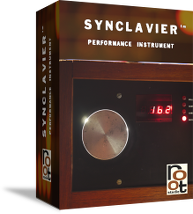
Synclavier - pure history!

US$ 19.00
Listen to Stefan talk about the history of the Synclavier and enjoy close-up footage of the machine and musical excerpts.
When you read or hear about references to the Synclavier, in all likelihood it is about the Synclavier II, a much more famous (and much more capable) instrument that offered high quality sampling in addition to FM voices. The predecessor, by contrast, is so little known that most people have never heard or even seen a picture of it. A mere 13 units were built, one of which lacked the optional black and white keyboard. At root studio, we were fortunate to own one of these rarities for more than 30 years. It originally belonged to the University of Victoria in British Columbia.
The Synclavier Performance Instrument, as it was correctly called, offered a factory disk that turned the general purpose main frame computer into a ready-to-play synthesizer with 16 factory and 16 user presets, plus an on-board sequencer with 4 factory and 4 user sequences. It featured 8-voice polyphony with 2-operator FM synthesis. The waveforms were not restricted to sine waves, as employed later by the famous Yamaha DX line of synthesizers. Instead, complex wave shapes with up to 16 harmonics could be specified by the user, with or without an adjustable frequency modulation index and ratio. Arbitrary octave equivalent scales could quickly be dialed in and saved along with the user presets.
The flexibility of the instrument allowed it to boot from custom programmed system disks. This could completely transform the instrument into something else altogether. This option was exploited by several universities, who were the prime customers for the Synclavier. At Brown University, for example, the FM voices were not used at all. Instead, the entire computing power was utilized for a single voice with up to 255 harmonics, each with their own envelope control. Depending on the complexity, such finesse could sometimes lead to the processor choking.
At the University of Victoria, professor Doug Collinge created a real time environment called Moxie which allowed users to completely tailor the hardware to their needs. This environment allowed algorithmic compositions with or without real time interaction, arbitrarily complex waveforms, 4 channel sound distribution, interfacing to analog synthesizers, random or fixed modulation of any parameter, CRT output for user interaction or monitoring, and much more with very little coding.
If you want to listen to some excerpts of algorithmic compositions created on the Synclavier with Moxie, please visit this link.
